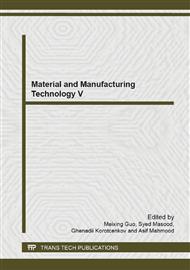p.373
p.379
p.384
p.389
p.394
p.398
p.402
p.408
p.413
Anticandidal Activity of Cratoxylum formosum Gum and its Cytotoxicity
Abstract:
Cratoxylum formosum is a plant widely distributed in mountainous area of various Asian countries. The extract prepared from the burnt bark has been used among the local people as a varnish to prevent tooth decay and other oral diseases. The aim of this study was to examine antifungal activity of C. formosum gum against Candida albicans and to evaluate its cytotoxicity. The gum prepared from the extract of C. formosum was investigated for antimicrobial activity against 3 strains of C. albicans. Inhibition of microbial growth was primarily tested by agar diffusion method. A two-fold broth dilution method was then used to determine the minimum inhibitory concentration (MIC) of the gum. Based on the MIC value, cytotoxicity test was performed on mouse fibroblasts (ATCC clone 929) using agar overlay technique. Inhibitory effect of the gum was seen against C. albicans with zones of inhibition ranging from 8.0 to 9.3 mm. MIC values were between 0.50 and 1.25 mg/mL. In term of cytotoxicity, C. formosum gum at the concentration of 20 MIC (25 mg/mL) was classified as grade 3 (moderate cytotoxicity) whereas those of 10 MIC and 1 MIC were grade 1 (slight cytotoxicity). In conclusion, the gum prepared from C. formosum extract exhibited antimicrobial activities against all the test strains of C. albicans. From the present study, it can be suggested that this plant can be used as a novel antifungal agent, effective against C. albicans infections, due to its inhibitory effects on C. albicans and acceptable biocompatibility. Further in vitro/in vivo studies should be conducted to understand the mechanisms of action and to establish the safe profile of this gum for clinical usage.
Info:
Periodical:
Pages:
394-397
Citation:
Online since:
June 2014
Keywords:
Price:
Сopyright:
© 2014 Trans Tech Publications Ltd. All Rights Reserved
Share:
Citation:


